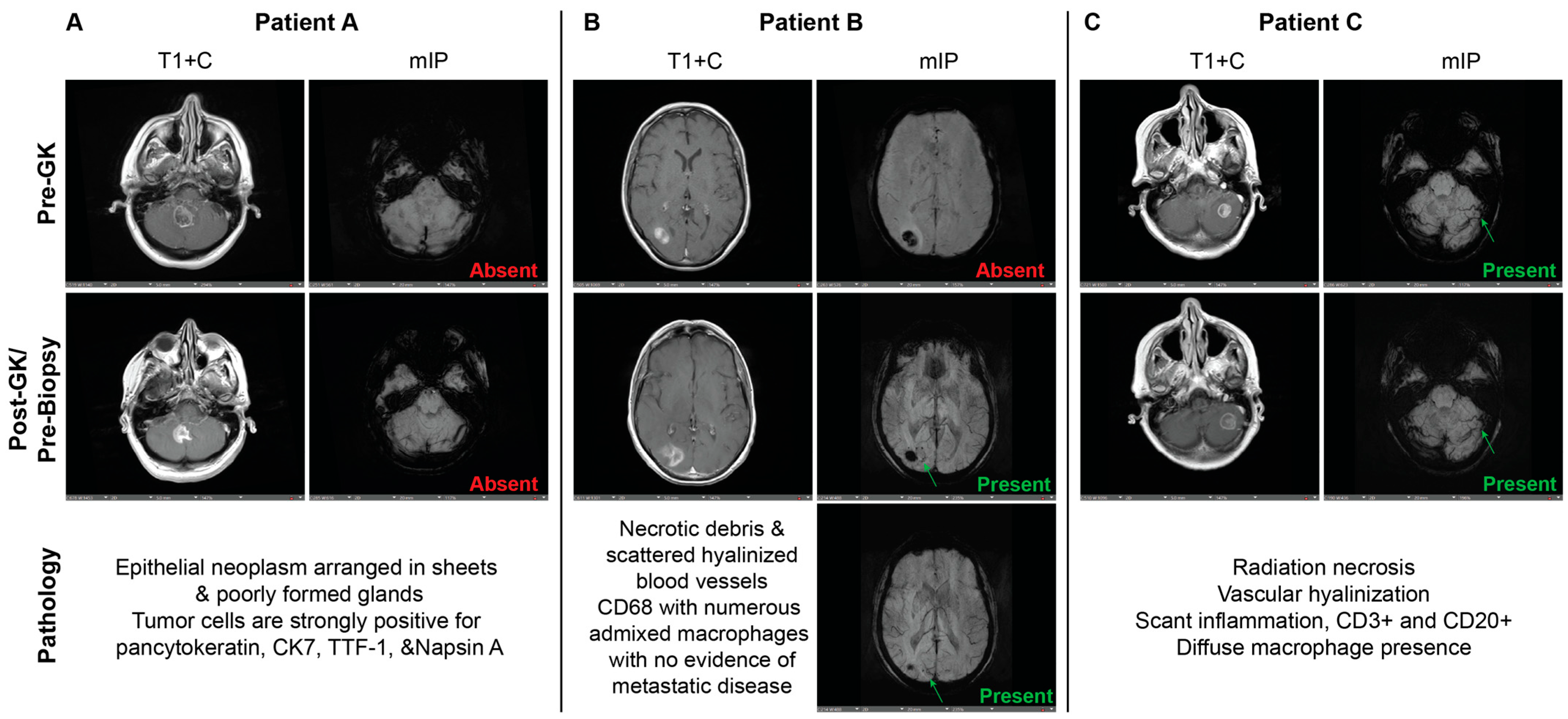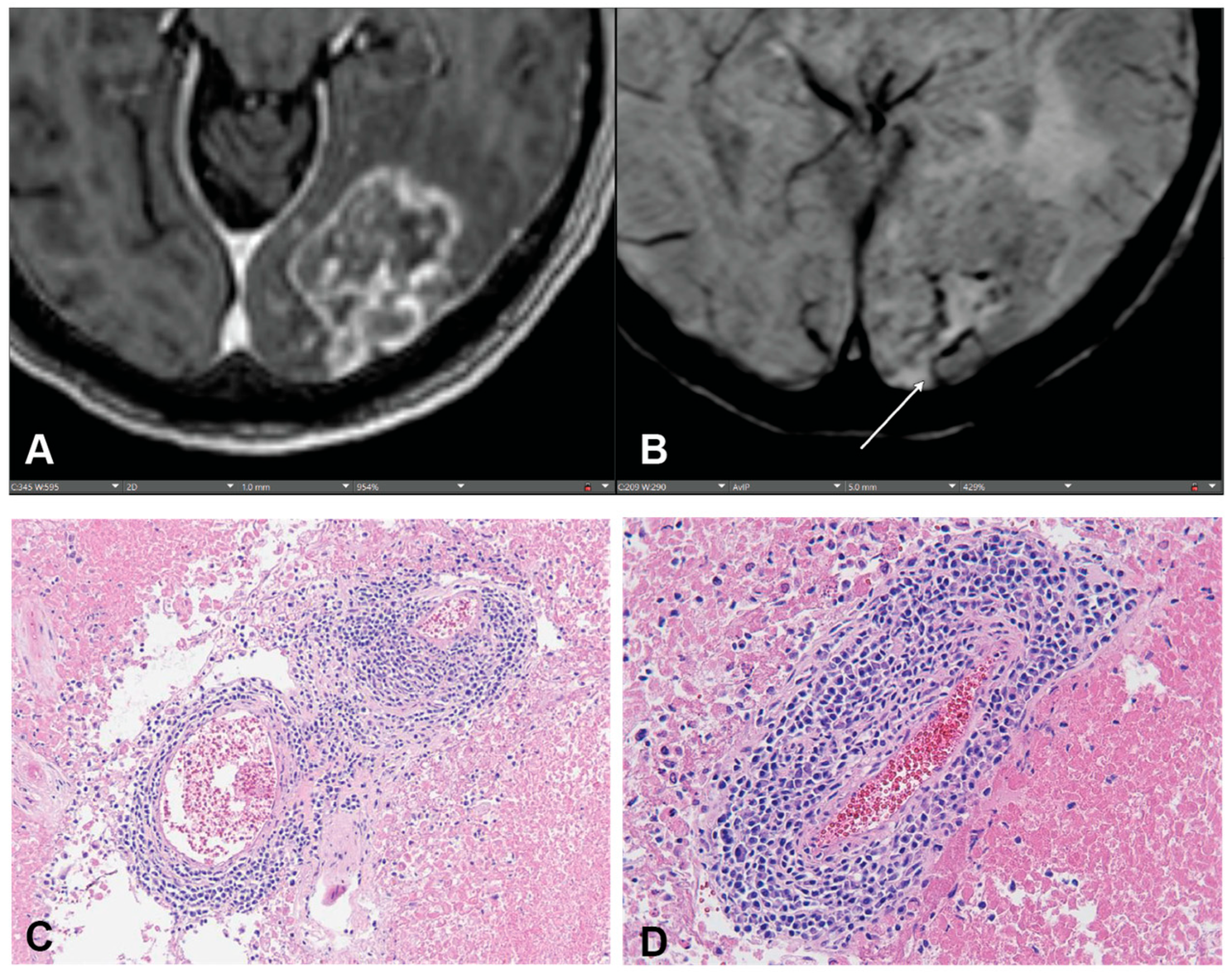The Central Vein Sign as a Radiologic Tool to Predict the Diagnosis of Radiation Necrosis in Intracranial Metastatic Cancer Patients
Abstract
1. Introduction
2. Brief Report
3. Discussion
Supplementary Materials
Author Contributions
Funding
Institutional Review Board Statement
Informed Consent Statement
Data Availability Statement
Conflicts of Interest
References
- Nieder, C.; Grosu, A.L.; Gaspar, L.E. Stereotactic radiosurgery (SRS) for brain metastases: A systematic review. Radiat. Oncol. 2014, 9, 155. [Google Scholar] [CrossRef] [PubMed]
- Yoritsune, E.; Furuse, M.; Kuwabara, H.; Miyata, T.; Nonoguchi, N.; Kawabata, S.; Hayasaki, H.; Kuroiwa, T.; Ono, K.; Shibayama, Y.; et al. Inflammation as well as angiogenesis may participate in the pathophysiology of brain radiation necrosis. J. Radiat. Res. 2014, 55, 803–811. [Google Scholar] [CrossRef] [PubMed]
- Ali, F.S.; Arevalo, O.; Zorofchian, S.; Patrizz, A.; Riascos, R.; Tandon, N.; Blanco, A.; Ballester, L.Y.; Esquenazi, Y. Cerebral radiation necrosis: Incidence, pathogenesis, diagnostic challenges, and future opportunities. Curr. Oncol. Rep. 2019, 21, 66. [Google Scholar] [CrossRef] [PubMed]
- Abdulla, S.; Saada, J.; Johnson, G.; Jefferies, S.; Ajithkumar, T. Tumour progression or pseudoprogression? A review of post-treatment radiological appearances of glioblastoma. Clin. Radiol. 2015, 70, 1299–1312. [Google Scholar] [CrossRef] [PubMed]
- Mayo, Z.S.; Halima, A.; Broughman, J.R.; Smile, T.D.; Tom, M.C.; Murphy, E.S.; Suh, J.H.; Lo, S.S.; Barnett, G.H.; Wu, G.; et al. Radiation necrosis or tumor progression? A review of the radiographic modalities used in the diagnosis of cerebral radiation necrosis. J. Neuro-Oncol. 2023, 161, 23–31. [Google Scholar] [CrossRef] [PubMed]
- Romano, A.; Moltoni, G.; Blandino, A.; Palizzi, S.; Romano, A.; de Rosa, G.; De Blasi Palma, L.; Monopoli, C.; Guarnera, A.; Minniti, G.; et al. Radiosurgery for Brain Metastases: Challenges in Imaging Interpretation after Treatment. Cancers 2023, 15, 5092. [Google Scholar] [CrossRef] [PubMed]
- Lasocki, A.; Sia, J.; Stuckey, S.L. Improving the diagnosis of radiation necrosis after stereotactic radiosurgery to intracranial metastases with conventional MRI features: A case series. Cancer Imaging 2022, 22, 33. [Google Scholar] [CrossRef] [PubMed]
- Hainc, N.; Alsafwani, N.; Gao, A.; O’halloran, P.J.; Kongkham, P.; Zadeh, G.; Gutierrez, E.; Shultz, D.; Krings, T.; Alcaide-Leon, P. The centrally restricted diffusion sign on MRI for assessment of radiation necrosis in metastases treated with stereotactic radiosurgery. J. Neuro-Oncol. 2021, 155, 325–333. [Google Scholar] [CrossRef] [PubMed]
- Caulfield, J.I.; Kluger, H.M. Emerging studies of melanoma brain metastasis. Curr. Oncol. Rep. 2022, 24, 585–594. [Google Scholar] [CrossRef] [PubMed]
- Sati, P.; Oh, J.; Constable, R.T.; Evangelou, N.; Guttmann, C.R.G.; Henry, R.G.; Klawiter, E.C.; Mainero, C.; Massacesi, L.; McFarland, H.; et al. The central vein sign and its clinical evaluation for the diagnosis of multiple sclerosis: A consensus statement from the North American Imaging in Multiple Sclerosis Cooperative. Nat. Rev. Neurol. 2016, 12, 714–722. [Google Scholar] [CrossRef] [PubMed]
- Sinnecker, T.; Clarke, M.A.; Meier, D.; Enzinger, C.; Calabrese, M.; De Stefano, N.; Pitiot, A.; Giorgio, A.; Schoonheim, M.M.; Paul, F.; et al. Evaluation of the central vein sign as a diagnostic imaging biomarker in multiple sclerosis. JAMA Neurol. 2019, 76, 1446–1456. [Google Scholar] [CrossRef] [PubMed]
- Matsui, J.K.; Perlow, H.K.; Raj, R.K.; Nalin, A.P.; Lehrer, E.J.; Kotecha, R.; Trifiletti, D.M.; McClelland, S.; Kendra, K.; Williams, N.; et al. Treatment of Brain Metastases: The Synergy of Radiotherapy and Immune Checkpoint Inhibitors. Biomedicines 2022, 10, 2211. [Google Scholar] [CrossRef] [PubMed]


Disclaimer/Publisher’s Note: The statements, opinions and data contained in all publications are solely those of the individual author(s) and contributor(s) and not of MDPI and/or the editor(s). MDPI and/or the editor(s) disclaim responsibility for any injury to people or property resulting from any ideas, methods, instructions or products referred to in the content. |
© 2025 by the authors. Published by MDPI on behalf of the Swiss Federation of Clinical Neuro-Societies. Licensee MDPI, Basel, Switzerland. This article is an open access article distributed under the terms and conditions of the Creative Commons Attribution (CC BY) license (https://creativecommons.org/licenses/by/4.0/).
Share and Cite
Antonios, J.P.; Adenu-Mensah, N.; Theriault, B.C.; Millares-Chavez, M.; Huttner, A.; Aboian, M.; Chiang, V.L. The Central Vein Sign as a Radiologic Tool to Predict the Diagnosis of Radiation Necrosis in Intracranial Metastatic Cancer Patients. Clin. Transl. Neurosci. 2025, 9, 10. https://doi.org/10.3390/ctn9010010
Antonios JP, Adenu-Mensah N, Theriault BC, Millares-Chavez M, Huttner A, Aboian M, Chiang VL. The Central Vein Sign as a Radiologic Tool to Predict the Diagnosis of Radiation Necrosis in Intracranial Metastatic Cancer Patients. Clinical and Translational Neuroscience. 2025; 9(1):10. https://doi.org/10.3390/ctn9010010
Chicago/Turabian StyleAntonios, Joseph P., Nana Adenu-Mensah, Brianna C. Theriault, Miguel Millares-Chavez, Anita Huttner, Mariam Aboian, and Veronica L. Chiang. 2025. "The Central Vein Sign as a Radiologic Tool to Predict the Diagnosis of Radiation Necrosis in Intracranial Metastatic Cancer Patients" Clinical and Translational Neuroscience 9, no. 1: 10. https://doi.org/10.3390/ctn9010010
APA StyleAntonios, J. P., Adenu-Mensah, N., Theriault, B. C., Millares-Chavez, M., Huttner, A., Aboian, M., & Chiang, V. L. (2025). The Central Vein Sign as a Radiologic Tool to Predict the Diagnosis of Radiation Necrosis in Intracranial Metastatic Cancer Patients. Clinical and Translational Neuroscience, 9(1), 10. https://doi.org/10.3390/ctn9010010





